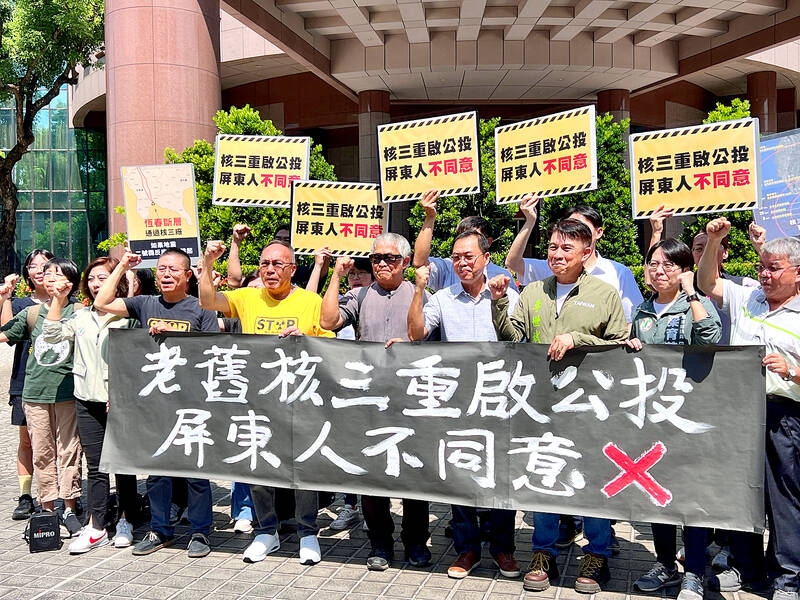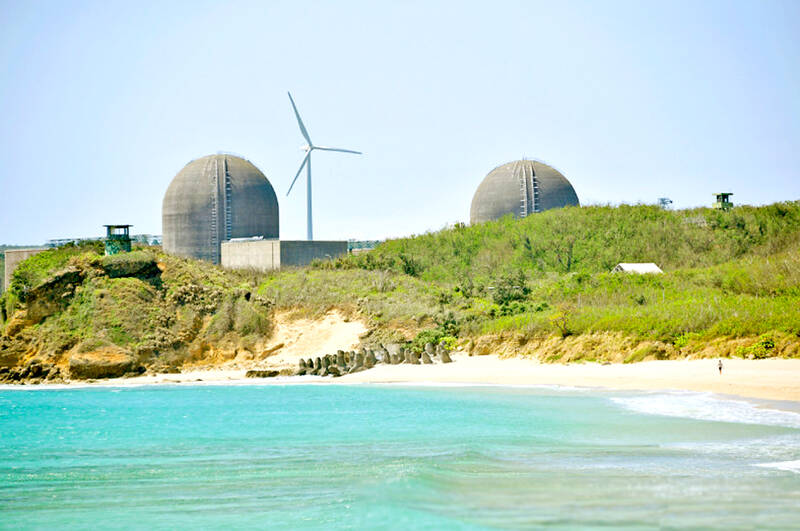In the run-up to the referendum on re-opening Pingtung County’s Ma-anshan Nuclear Power Plant last month, the media inundated us with explainers. A favorite factoid of the international media, endlessly recycled, was that Taiwan has no energy reserves for a blockade, thus necessitating re-opening the nuclear plants. As presented by the Chinese-language CommonWealth Magazine, it runs: “According to the US Department of Commerce International Trade Administration, 97.73 percent of Taiwan’s energy is imported, and estimates are that Taiwan has only 11 days of reserves available in the event of a blockade.”
This factoid is not an outright lie — that would be too easy to spot. Instead it is an abuse of reason. Industrial use accounts for over half of Taiwan’s electricity demand. Most of that, along with a considerable chunk of Taiwan’s commercial demand, would collapse in the event of a blockade. What is left of residential demand (less than 20 percent of demand on a good day) and a handful of shops and factories could run for months on coal and renewables, as Ko Yun-ling (柯昀伶) and Chao Chia-wei (趙家緯) pointed out in a piece at Taiwan Insight earlier this year.
This construct thus presented to readers a simple morality play: Democratic Progressive Party (DPP) policy bad! Nukes good! Energy security! Many writers reinforced this by connecting the nuke plant shut-downs to DPP policy and not to the fact that spent fuel pools were full and the plants had reached their planned lifetimes.

Photo: Lo Hsin-chen, Taipei Times
Writing on the referendum, the well-known site Domino Theory cited Chao, research director at the Taiwan Climate Action Network, who argued a blackout in 2017 “increased support for nuclear power by fostering anxiety about Taiwan’s energy supply.” The blackout occurred “even though all three nuclear plants were operational at the time.”
NUCLEAR UNRELIABLE
Years have passed since the closure of the plants in the north, and the public has forgotten how nuclear power actually functioned. Chao’s comment shows how public forgetting, even expert forgetting, is an important factor in the resurgence in local support for nuclear power. In fact, the unreliability of the nuclear plants caused the blackout. The reason the electricity system was operating at its margin was that reactors were offline. A reactor at the Jinshan Nuclear Power Plant had been offline for three years at that point.

Photo: TT file photo
As the redoubtable Timothy Ferry observed in the News Lens in October of that year: “This past June 10, following the closure of the Jinshan Nuclear Power Plant and prior to the restart of Kuosheng [Nuclear Power Plant] reactor-1, nuclear power fell to as low as 3 percent of Taiwan’s power generation when maintenance problems at the Ma-anshan plant took one of its reactors offline for weeks.”
A 2016 piece by Ferry predicted thin power reserves in the coming summers because reactors were out of service.
“Data provided by the Atomic Energy Council shows that since 2002, the nation’s three nuclear power plants have experienced a total of 29 trigger events,” the Taipei Times editorialized in August of 2017.
“In contrast to the international concerns about Taiwan’s energy security,” the Financial Times described, speaking of the current referendum, “the domestic debate has centered on air pollution and economic growth.”
Hardly surprising, given the fearmongering about electricity, a staple of Chinese Nationalist Party (KMT) propaganda since the early 2000s. The educational system is a weeding out system, and it instills in people a visceral fear of being weeded out of the international economy, a fear reinforced by the nation’s lack of international recognition. Contextualizing nuclear power as an economic growth driver appeals to that fear.
“Taiwanese have long heard that nuclear power is the cure-all to the nation’s energy problems,” the 2017 editorial cited above pointed out. The recent referendum was driven by that magical thinking.
Proponents leveraged fear by pointing out how Taiwan needs power to drive the AI boom, with the unspoken corollary that Taiwan would be weeded out if there was no AI boom. Never mind that it will be years before any nuclear power plant can be up and running again, yet the AI need is already materializing. The obvious move is to ramp up renewables, which now supply around 13 percent of Taiwan’s power. But instead, the Taiwan People’s Party referendum, which was supported by the KMT, has the nation talking about nuclear power. That diversion is its entire purpose.
Moreover, the “pollution” claims about nuclear power conceal how “emissions-free” nuclear power is used to maintain Taiwan’s inefficient, heavily-subsidized, high carbon economy, as I have written before. For example, in 2008, during the debates over the now-dead Fourth Nuclear Power Plant, a Taiwan News editorial observed that “environmentalists estimate that over 83 percent of the alleged annual carbon dioxide reduction of 18 million tons claimed for Nuclear Four could be realized simply by vetoing plans by the Formosa Plastics Group to build a steel refinery on the Yunlin coast”.
LOSS OF REWARDS
Etta Lee (李若慈), a masters student at National Taiwan University (NTU), last year did fieldwork in Hengchun Township (恆春) in Pingtung County that explored local support for the nearby nuclear power plant. On Facebook she observed: “When central and local policy debates focus on technology and safety, for most residents it is less about supporting extension or restarting than about worrying about the economic consequences of the suspension of nuclear plants — such as reduced jobs, cancellation of rewards or loss of local infrastructure resources that politicians fear.”
Locals, she notes (especially in the Kenting peninsula where there is little industry and tourism is in dire straits), are responding pragmatically to the risks and uncertainties of their economic existence “in a highly dependent and non-choice structure, rather than a positive identification of nuclear energy itself.” Fear is a powerful motivator.
The Hengchun peninsula has a large population of indigenous community. That too is an old pattern with nuclear power. Everyone is familiar with how the indigenous people on Taitung County’s Orchid Island (Lanyu, 蘭嶼) were tricked into accepting low-level nuclear waste. In 2012, then-Democratic Progressive Party (DPP) legislator (now Vice President) Hsaio Bi-khim (蕭美琴) was alerted by locals to drilling in Hualien County’s Sioulin Township (秀林). Hsiao discovered that Taipower was looking for potential sites for geological disposal of Taiwan’s high level nuclear waste. Taipower had not bothered to seek permission or even to inform the locals of the drilling program. The township’s residents are largely indigenous.
Etta Lee also collected local stories about similar trickery in the development of the Ma-ashan plant. The locals were told that the site was ideal for an international port, one that would have spanned the entire end of the peninsula. Plans for the port were even posted on local bulletin boards. Then one day it suddenly became a nuclear power plant, and the international port was given to Taichung.
WHY MA-ANSHAN?
Why was the referendum about Ma-anshan? Because it is about as far from Taipei as one can get and still be in Taiwan. There was no reason restarting the northern nuclear power plants could not have been included. Distance from the colonial core was an important part of the appeal of the referendum, an appeal echoed in the proposals following its failure to store nuclear waste on the islands off of China.
Moreover, had the northern reactors been included, attention would have been drawn to the KMT’s role in ensuring their closure, and to local residents’ objections to the nuclear power plants and nuclear waste storage. Finally, as I noted a few months ago, there was little threat a successful referendum could actually result in re-opening the plant. Years will pass before a site for storing spent fuel is identified, storage constructed, the fuel removed, safety evaluations conducted and the plant re-started.
David Reid in 2011 wrote for this paper on the Fourth Nuclear Plant in New Taipei City’s Gongliao District (貢寮), noting that hundreds of billions of New Taiwan dollars had been spent on the plant with no electricity generation in sight. The plant was mothballed in 2015.
“What if that same amount of money had been invested in renewable energy projects beginning from 1997?” he asked. “These projects would have begun to generate power in a much shorter time frame,” he answered, while also driving development of a local renewable energy industry.
Nuclear power not only crowds out spending on renewables, it crowds out discussion and development of them.
For the KMT the referendum was a success. Foreign commentators dutifully forwarded its construction of Taiwan’s energy policy and its criticisms of the DPP, masked as “reporting.” Observers were quick to point out that it might make DPP President William Lai (賴清德) soften his stance on nuclear power, as if he hadn’t been indicating that since the fall of 2023 when he was a presidential candidate. The referendum was overwhelmingly supported but failed to pass, committing the KMT to nothing.
At least, until the next KMT-inspired performative referendum on nuclear power.
Notes from Central Taiwan is a column written by long-term resident Michael Turton, who provides incisive commentary informed by three decades of living in and writing about his adoptive country. The views expressed here are his own.

This month the government ordered a one-year block of Xiaohongshu (小紅書) or Rednote, a Chinese social media platform with more than 3 million users in Taiwan. The government pointed to widespread fraud activity on the platform, along with cybersecurity failures. Officials said that they had reached out to the company and asked it to change. However, they received no response. The pro-China parties, the Chinese Nationalist Party (KMT) and Taiwan People’s Party (TPP), immediately swung into action, denouncing the ban as an attack on free speech. This “free speech” claim was then echoed by the People’s Republic of China (PRC),

Exceptions to the rule are sometimes revealing. For a brief few years, there was an emerging ideological split between the Democratic Progressive Party (DPP) and Chinese Nationalist Party (KMT) that appeared to be pushing the DPP in a direction that would be considered more liberal, and the KMT more conservative. In the previous column, “The KMT-DPP’s bureaucrat-led developmental state” (Dec. 11, page 12), we examined how Taiwan’s democratic system developed, and how both the two main parties largely accepted a similar consensus on how Taiwan should be run domestically and did not split along the left-right lines more familiar in

Specialty sandwiches loaded with the contents of an entire charcuterie board, overflowing with sauces, creams and all manner of creative add-ons, is perhaps one of the biggest global food trends of this year. From London to New York, lines form down the block for mortadella, burrata, pistachio and more stuffed between slices of fresh sourdough, rye or focaccia. To try the trend in Taipei, Munchies Mafia is for sure the spot — could this be the best sandwich in town? Carlos from Spain and Sergio from Mexico opened this spot just seven months ago. The two met working in the

Many people in Taiwan first learned about universal basic income (UBI) — the idea that the government should provide regular, no-strings-attached payments to each citizen — in 2019. While seeking the Democratic nomination for the 2020 US presidential election, Andrew Yang, a politician of Taiwanese descent, said that, if elected, he’d institute a UBI of US$1,000 per month to “get the economic boot off of people’s throats, allowing them to lift their heads up, breathe, and get excited for the future.” His campaign petered out, but the concept of UBI hasn’t gone away. Throughout the industrialized world, there are fears that